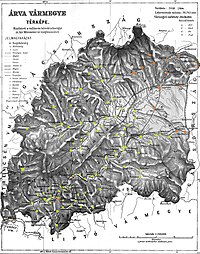Árva (county)
Geography

Between 1804-1854 and 1860-1920, Árva County shared borders with Austrian Galicia and the Hungarian counties of Trencsén, Turóc and Liptó County. The county's territory was situated along the Árva (Orava) river between Zázriva (Zázrivá) and the Tatra mountains. Its area was 2,019 km (780 sq mi) around 1910. Now the territory is divided between Poland and Slovakia. The main Polish town of Orava is Jabłonka.
Capitals
The county seat was at the Orava Castle (Hungarian: Árva vára). After the destruction of the town by the Lithuanian troops in 1683, the seat was moved to Alsókubin (also Kolbin, Kublen, Kubin, Also Helben, Clbin, Culbyn, Cublyn, present-day Dolný Kubín).
History
Emerging from the Zólyom royal land (Hungarian: zólyomi erdőispánság), the first written mention about Árva County is from 1349. However, the territory had been still referenced as a district in 1351-1368 and it finally became a county with its own self-administration in 1370.
On 13 September 1850, following the Revolutions of 1848 in the Austrian Empire, Árva and Turóc counties were merged to form Árva-Turóc county, becoming part of the Military District of Preßburg; this merger was re-affirmed in 1853 and 1854. In 1860 Hungary's pre-1850 counties, including Árva, were restored.
In the aftermath of World War I, the territory of the whole county became part of newly formed Czechoslovakia. After a border dispute (treated in detail under Polish–Czechoslovak border conflicts) several villages in the north-east territory were exchanged between Poland and Czechoslovakia. The former county's Czechoslovak part was abolished with effective date 1 January 1923 and its territory became a part of Váh County.
Demographics

| Census | Total | Slovak | Hungarian | German | Other or unknown |
|---|---|---|---|---|---|
| 1880 | 81,643 | 75,901 (96.26%) | 355 (0.45%) | 2,213 (2.81%) | 378 (0.48%) |
| 1890 | 84,820 | 81,600 (96.20%) | 773 (0.91%) | 1,918 (2.26%) | 529 (0.62%) |
| 1900 | 85,009 | 80,487 (94.68%) | 1,494 (1.76%) | 2,127 (2.50%) | 901 (1.06%) |
| 1910 | 78,745 | 59,096 (75.05%) | 2,000 (2.54%) | 1,518 (1.93%) | 16,131 (20.49%) |

| Census | Total | Roman Catholic | Lutheran | Jewish | Other or unknown |
|---|---|---|---|---|---|
| 1880 | 81,643 | 71,407 (87.46%) | 7,272 (8.91%) | 2,934 (3.59%) | 30 (0.04%) |
| 1890 | 84,820 | 74,892 (88.30%) | 7,153 (8.43%) | 2,742 (3.23%) | 33 (0.04%) |
| 1900 | 85,009 | 75,337 (88.62%) | 6,936 (8.16%) | 2,648 (3.11%) | 88 (0.10%) |
| 1910 | 78,745 | 69,788 (88.63%) | 6,674 (8.48%) | 2,205 (2.80%) | 78 (0.10%) |
Districts

In the early 20th century, the districts and their capitals were:
| Districts (járás) | |
|---|---|
| District | Capital |
| Alsókubin | Alsókubin (now Dolný Kubín) |
| Námesztó | Námesztó (now Námestovo) |
| Trsztena | Trsztena (now Trstená) |
| Vár | Turdossin (now Tvrdošín) |
Notes
References
- ^ Viliam, Volko; Kiš, Miloslav (2007). Stručný vývoj územného a administratívneho členenia Slovenska [A Brief History of the Territorial and Administrative Division of Slovakia]. Bratislava: Ministry of Interior of the Slovak Republic. pp. 21, 23.
- ^ Maslíková, Ľudmila (2010). "Hospodárske pomery vo Veličnej na základe urbárov z 17. a prvej polovice 18. storočia". Historia nova (in Slovak) (1). Bratislava: Filozofická fakulta Univerzity Komenského: 46. ISBN 978-80-8127-160-1.
- ^ Maslíková 2010, p. 41.
- ^ "Verordnung des Ministeriums des Inneren vom 13. September 1850 wodurch in Gemäßheit der Allerhöchsten Entschließung vom 8. September 1850 nachstehende Bestimmungen über die Einrichtung der politischen Verwaltungsbehörden im Königreiche Ungarn erlassen und zur allgemeinen Kenntniß gebracht werden". ÖNB-ALEX - Historische Rechts- und Gesetztexte Online (in German). 1850-09-13. Retrieved 2024-10-08.
- ^ "Verordnung des Minister des Inneren, der Justiz and der Finanzen vom 19. Jänner 1853, womit die Allerhöchsten Entschließung über die Einrichtung ung Amtswirksamkeit der Statthalterei, der Comitatsbehörden und Stuhlrichterämter, dann über die Einrichtung der Gerichtsbehörden und das Schema der systemisirten Gehalte und Diätenclassen für das Königreich Ungarn, sowie über die Durchführung dieser Organisirung kundgemacht werden". ÖNB-ALEX - Historische Rechts- und Gesetztexte Online (in German). 1853-01-19. Retrieved 2024-10-08.
Seine k. k. Apostolische Majestät haben zu befehlen geruht, daß das Arváer Comitat mit dem Thuroczer und das Békeser mit dem Csanader Comitate vereinigt, übrigens aber bezüglich des Umfanges der Comitate die jetzt bestehende Eintheilung vorbehaltlich jener Abhänderung zur Grundlage zu dienen habe, welche etwa bei der Durchführung der Organisirung für zweckmäßigerkannt werden.
- ^ "Verordnung der Ministerien des Inneren, der Justiz und der Finanzen vom 6. April 1854 betreffend die politische und gerichtliche Oraganisierung des Königreichs Ungarn". ÖNB-ALEX - Historische Rechts- und Gesetztexte Online (in German). 1854-04-06. Retrieved 2024-10-08.
- ^ Volko-Kiš 2007, p. 38.
- ^ "Az 1881. év elején végrehajtott népszámlálás főbb eredményei megyék és községek szerint rendezve, II. kötet (1882)". library.hungaricana.hu. Retrieved 2021-09-28.
- ^ "A Magyar Korona országainak helységnévtára (1892)". library.hungaricana.hu. Retrieved 2021-09-29.
- ^ "A MAGYAR KORONA ORSZÁGAINAK 1900". library.hungaricana.hu. Retrieved 2021-09-29.
- ^ "KlimoTheca :: Könyvtár". Kt.lib.pte.hu. Retrieved 2021-09-29.
External links
- (in Slovak) http://www.orava.sk
- (in Polish) http://skansen.nowotarski.pl Orawa Ethnographic Park
- http://www.oravafoto.com
- (in Slovak) http://www.namestovo-orava.webnode.sk
